A stability ball is a beneficial tool for fitness training. There are 14 particularly effective exercises that use the stability ball to sculpt and strengthen your entire body, helping to improve your health and appearance.
This printable list of exercises – for both men and women – and the motivational video located lower within this article can help you get started.
If you happen to be over the age of 50, proceed gently and be mindful of your body’s limitations. The idea is to challenge yourself while preventing injury at the same time. All movements can be modified to match your unique circumstances.
Benefits of a Stability Ball
Though most people only use it to do crunches, many other important sculpting and strengthening exercises can be done with a stability ball.
An exercise ball can be so effective because it places your body into slightly unstable positions. These precarious positions:
- force the muscles of your core to engage
- develop your balance and agility.
Core strength is more important than most people realize.
When your core is strong, your vital organs are encased and protected by a shield of abdominal and lower back muscles. Your spine is safer, your posture is better, and you’re less likely to stumble or fall.
A strong core is a significant source of support for your body.
People with weak core muscles are making their joints, spine, and organs experience an unfair share of pressure.
Fortunately, there are 14 exercises for full-body training using a stability ball that helps give your body the mobility, strength, support, and skills it needs to thrive.

The human body adapts to movement patterns quickly.
For seasoned athletes especially, our bodies acclimate to programmed workouts within weeks – and this means our bodies don’t respond as quickly to the results we seek.
One solution to this is variation.
The stability ball can be an excellent way to add variation to stale workout regimes.
Essentially, the precariousness of the ball can trick your muscles into responding again.
The following full-body training session can be completed in under 45 minutes:
- Beginning-level athletes can do two sets of each exercise – 12 repetitions during each set.
- Intermediate-to-advanced athletes can do three sets.
- To keep your heart rate elevated during the training session, only take a one-minute break between sets.
Consider using a timer on your phone to time your rest periods between sets. One minute can easily become two or more if you’re not keeping an eye on the clock.
What follows are individual descriptions of each exercise.
Kneeling Roll-Out Warm-Up
To help get your body primed for the workout ahead, a first exercise should begin to wake up your core muscles with light movement and heat.
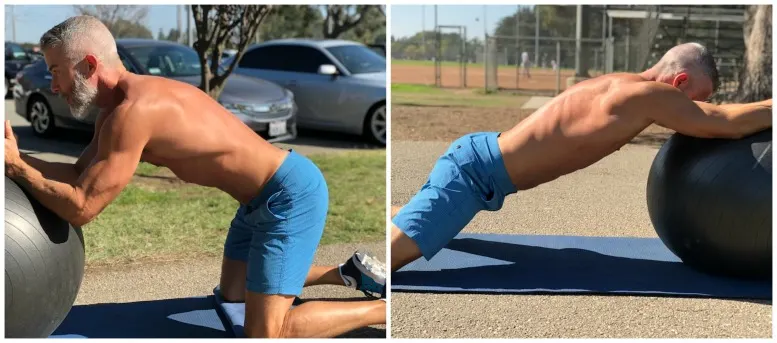
A kneeling roll-out should do the trick. Kneel on a folded towel – to protect your kneecaps – then lay your body weight on the ball via your elbows.
Roll out slowly and carefully, then pull back to the starting position with more speed.
Slow out, faster in.
Using tempo in this way – slowly out on the eccentric, lengthening negative, followed by a more explosive speed as you return to peak contraction – will increase your results.
Stability Ball Rollout: Standing Variation
Next, to increase the intensity a bit, do the same exercise – only this time, do it standing.
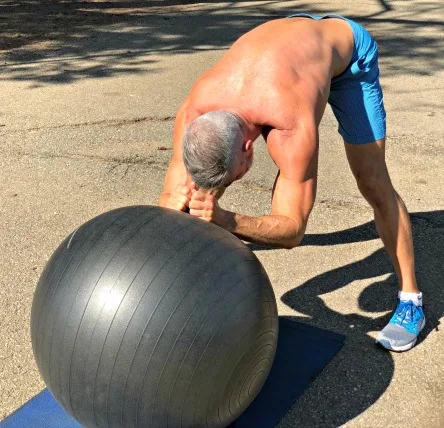
Be mindful of the shape of your abdominals when doing core work:
- Keep your top ribs compressed – not popped out. If your top ribs pop outward, your lower back will sway like an old horse, and a prime opportunity for abdominal conditioning will be lost.
- Protect your lower back area by keeping your pelvis centered and vacuuming in the muscle plate below your navel (people usually remember to pull in the muscles around their belly button but often forget about the critical area below it).
- Finally – and this is important – always visualize keeping your abdominal muscles long while doing ab work. Even when an exercise requires you to curve your spine and contract your core, you still want some length in that curved spine. You don’t want to develop strong abs shaped outward like a punching bag. Instead, you intend to create a strong core that is flat, taut, and lean – like a bulletproof shield.
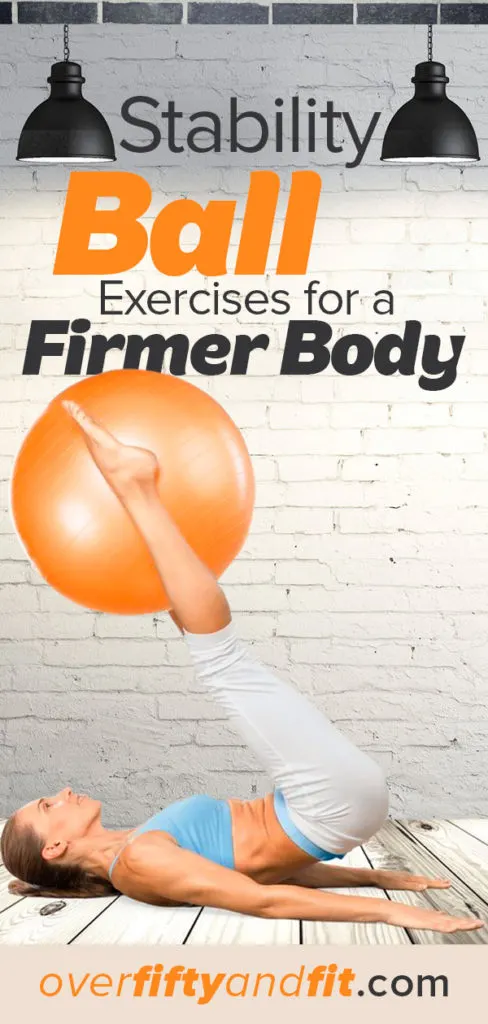
The Pelvic Scoop (Bonus Exercise)
This is an optional exercise for those athletes who are without lower back or neck issues.
On your back, place the stability ball between your lower legs and squeeze into the ball, securing it in place (this will activate your inner thighs).
Using your arms braced by your sides (see photo above), scoop your pelvis up so your tailbone lifts a couple of inches above the ground. Then return to starting position.
This movement is intended to be subtle yet deep.
For this exercise, less is more. That means that you can avoid using momentum by swinging your legs. Instead, initiate the movement by pulling your navel and lower-abdominal plate in intensely for each repetition as you exhale.
The Decline Push-up, Knee Tuck, and Pike Series
Time to turn up the intensity. This set of three consecutive stability ball exercises – decline push-up, knee tuck, and pike – will make you stronger and burn some serious calories.
Do all three exercises consecutively, 12 times, then take your one-minute break until the next superset.
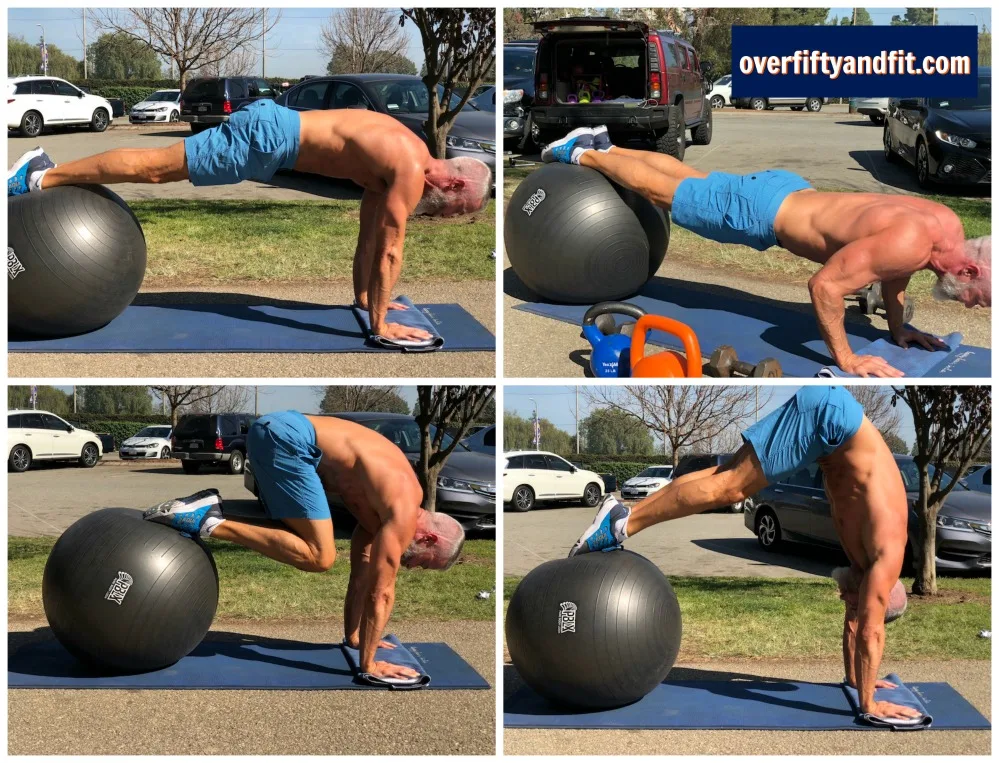
Be mindful of the health of your shoulders, wrists, and elbows:
- The more you engage your core muscles, the less weight your wrists and elbows will have to bear.
- Often, people find it helps their shoulder joints to point their elbows in-and-back a bit while lowering their chest to the ground (you can let them flare out a bit while coming back up).
- Be mindful of torque. To protect your wrists, you want to feel the entire palm of your hand making active contact with the mat – as if you have little suction cups on your palms. Then imagine twisting outward-clockwise a bit with your hands. This can help your shoulder joints, too.
Shoulder Openers
This exercise is excellent for improving shoulder mobility and posture. Lay face down on the ball, then raise straight arms up past the height of your head, palms facing each other.
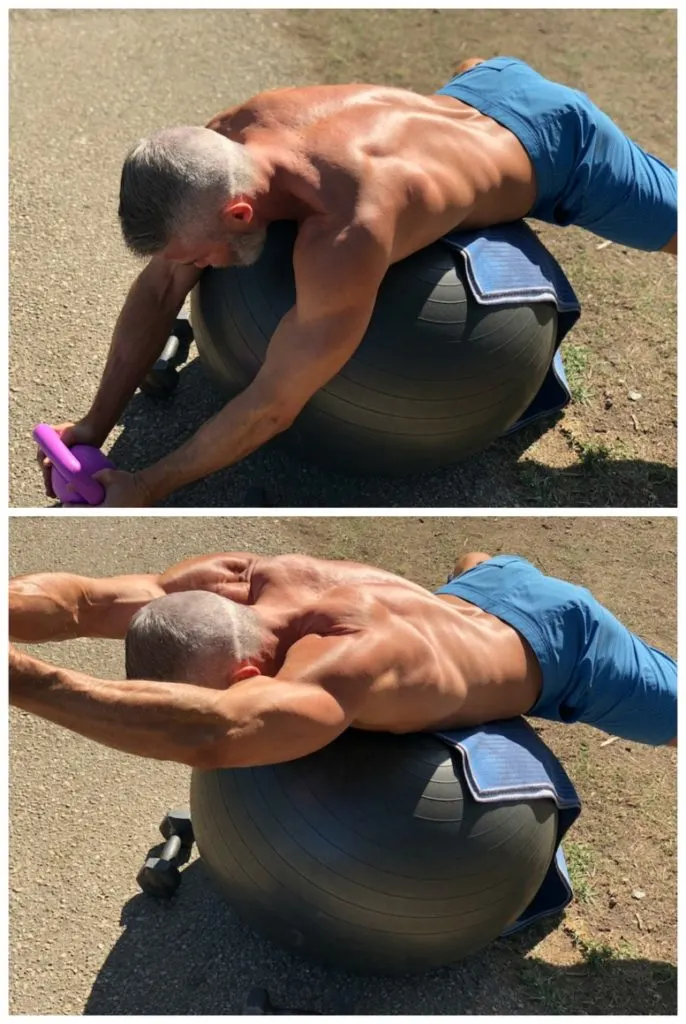
If you’re feeling more advanced, grab a small kettlebell or dumbbell to deeply work those posterior deltoids.
Tip: it’s a good idea to keep your shoulders away from your ears on this particular exercise. Imagine your shoulder cage widening and pressing down.
One-Arm Bent Over Rows with Stability Ball
Put one hand on the stability ball for support while “sawing” the other arm holding a weight.
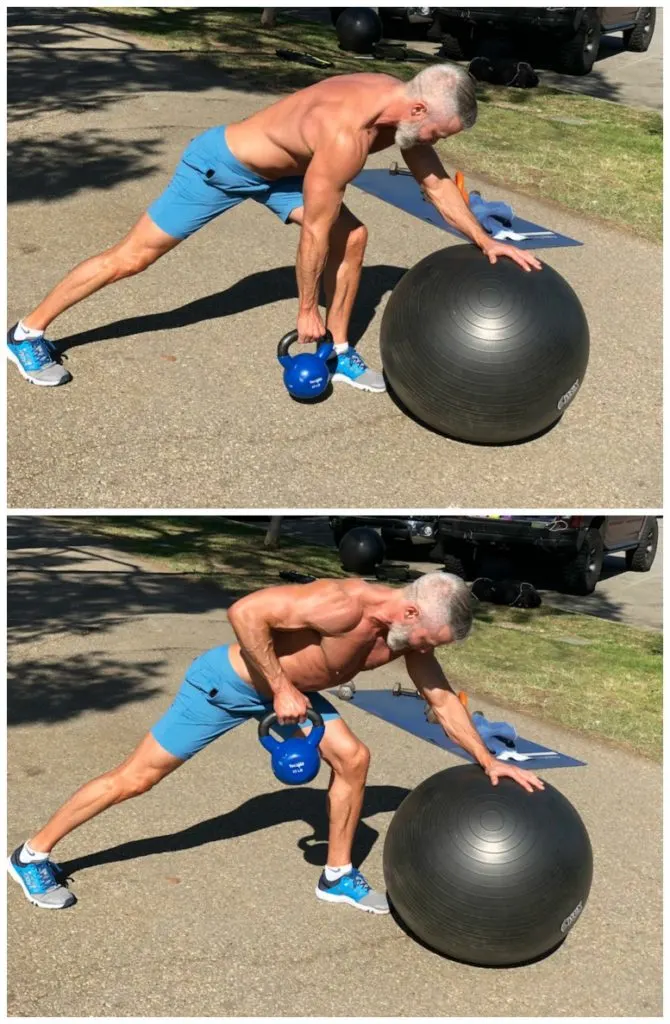
Don’t just pump your arm. The bicep will do all the work if you let it. Instead, initiate the movement from your lat (side back “wing” muscle).
Dumbbell Flies
If you happen to be over 50, it’s a good idea to keep your upper pecs firm and lifted – so that your nipples don’t start crawling downward toward your belly button. Gravity and time have a way of doing that.
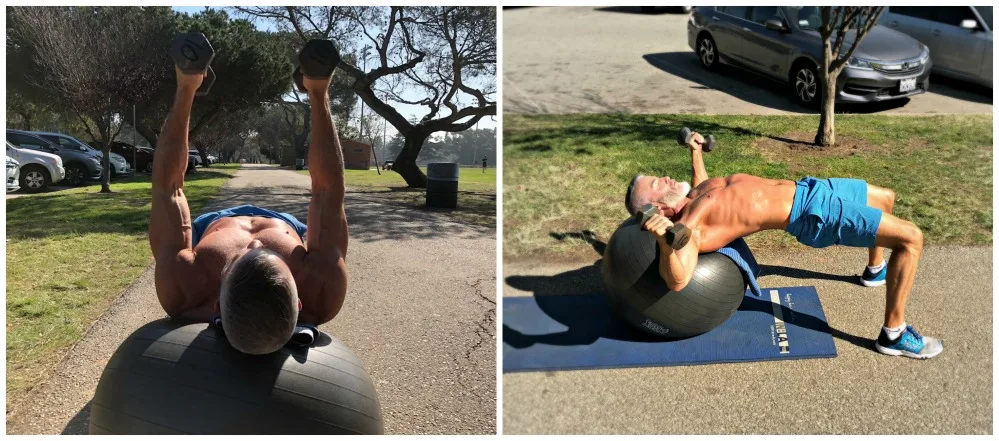
The good thing about the fly exercise is that – unlike presses – it doesn’t take a ton of weight to engage the chest muscles.
Keep the elbows soft on the way down, then straighten a bit (but don’t elbow-lock) on the way up, ending with the weights above your neck.
Your anterior deltoids will be tempted to take over the brunt of the work, so keep that mind-muscle connection going with your pecs.
Rear Delt Flies on Stability Ball
The human body wasn’t designed to text on phones or sit at desks or behind steering wheels. These habitual, sedentary activities in modern life tend to create slouchy spines.
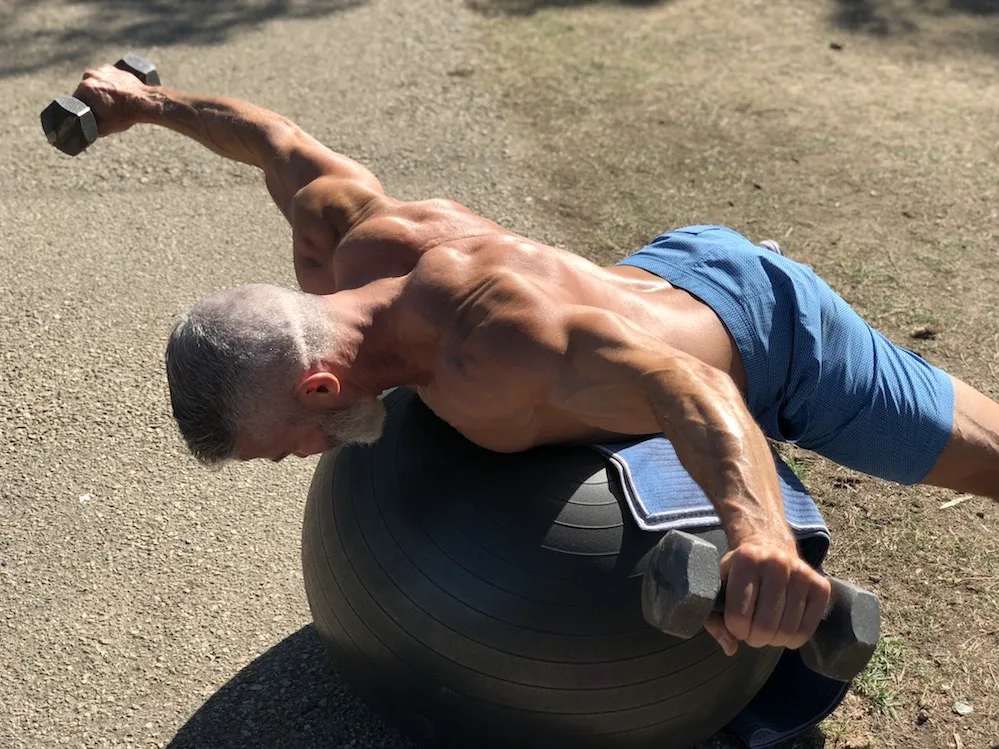
Fortunately, real delt flies are excellent for rear deltoids and the posterior chain and can be a really posture-improver. This exercise is similar to the chest fly but facing down.
Incline Chest/Tricep Push-Up, Followed by Pullovers
Sculpted arms are a good look for you. Pay attention to your wrists and elbows while doing incline chest-triceps push-ups. Modify according to the needs of your body.
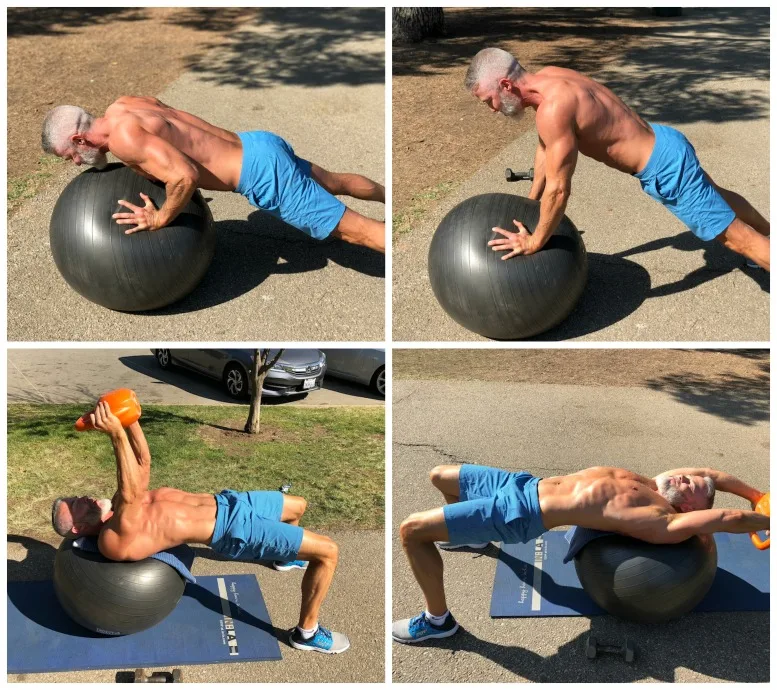
Then flip over, and do pullovers using a kettlebell or dumbbell. To engage more of the lat back muscles, prevent your elbows from flaring out too much – only keep them slightly soft.
Split Squats Followed by Overhead Squat Using Stability Ball
First, place the ball against a wall or fence, lean against it, and reach one leg back. Lower, then return upright. Repeat on other leg.
Be sure to activate your abdominal muscles while squatting. Keep your spine long, your pelvis centered, your waist tight, and your glutes squeezed.
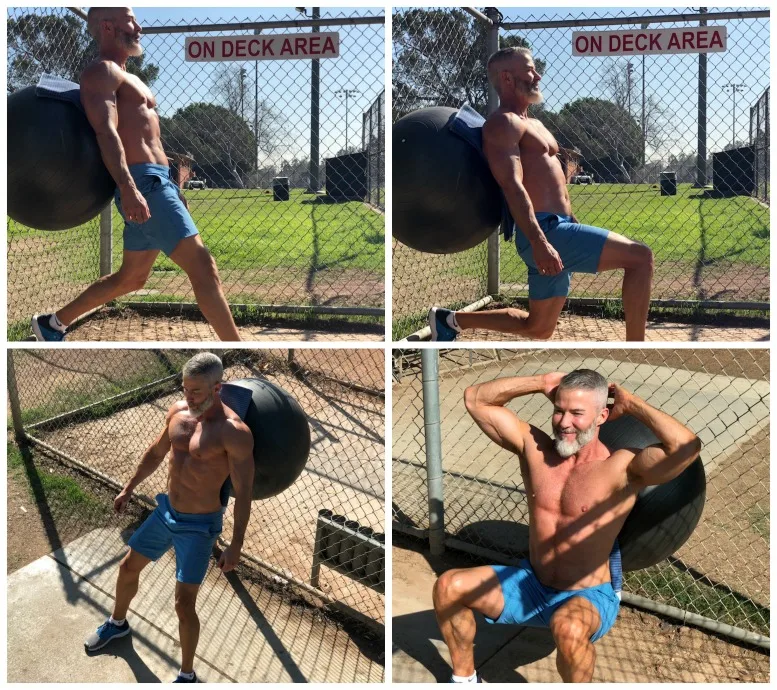
Follow split squats with overhead squats, still leaning back against the ball.
Be aware of your foot positioning –– try not to roll to one side of the foot.
It’s tempting to hold your breath, so remember to let your breathing help you.
It’s also essential to make symmetry a priority when sculpting the human body:
- I see lots of women who have leg muscles stronger than their upper bodies.
- And I see many men who have upper bodies that are disproportionately stronger than their lower halves.
Asymmetrical muscular development can pull on your joints and tissues unevenly – such as your spine, knees, shoulders, and pelvis – and create imbalances.
Take an honest, objective look at yourself in the mirror and evaluate your development through the lens of symmetry.
Whatever body part is lagging, train that area with a bit more effort and a bit more often.
Lower Back Extensions with Stability Ball
It’s good to develop the posterior chain of your core muscles, but always be extra careful with back extensions. Go slowly, listen to the needs of your spine, and remember that there isn’t a need to come much higher than hip level.
Lay on top of the ball, lowering your torso down so that your nose almost touches the ground. Then, raise up to hip height. (You’ll need to hook your feet under something, like a bench. Or have a workout buddy hold your heels.)

Finish this full-body workout with a prayer stretch – to loosen your lower back and hips, and to help your breathing gradually return to normal.
These 14 exercises represent only a fraction of the number of strengthening movements that can be done on a stability ball.
Whenever you exercise, engage your own sense of personal responsibility. The very nature of exercise involves some degree of risk, so be prepared and focused when attempting challenging movements. If something causes joint pain, don’t do it. Consult your medical doctor to get the all-clear before attempting new full-body training regimens.
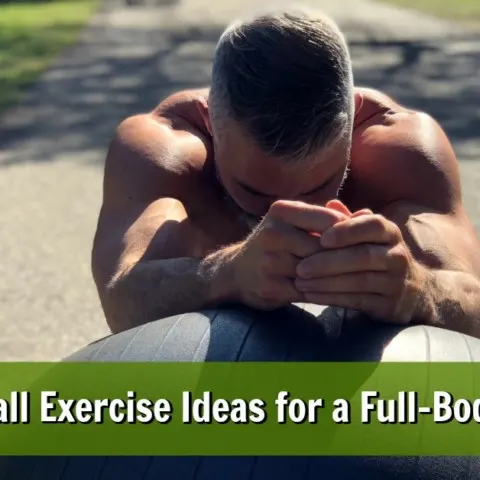
Stability Ball Workout
For a Sculpted Body – A stability ball is a beneficial workout tool for full-body fitness training, particularly for strengthening core muscles. Try these 14 exercises. See video, too!
Materials
- (minimal)
Tools
- One stability ball (pumped with ample amounts of air) and a pair of dumbbells or kettlebells.
Instructions
- Kneeling Roll-Out Warm Up
- Roll-Out (Standing Variation)
- Decline Push-Up
- Knee-Tuck
- Pike
- Shoulder Opener
- One-Arm Bent Over Row
- Dumbbell Fly
- Reverse Fly
- Incline Push-Up
- Pullover
- Split Squat
- Overhead Squat
- Lower Back Extension
Notes
All of these exercises utilize a stability ball or Swiss ball.
The stability ball can be an excellent way to:
- add variation to stale workout regimes
- trick the body into responding again
- develop core strength
- improve mobility.
Here's how to burn more calories as you're sculpting the major muscle groups of your body:
- Beginning-level athletes can two sets of each exercise – 12 repetitions during each set.
- Intermediate-to-advanced athletes can do three sets.
- To keep your heart rate elevated during the training session, take only a one-minute break between sets.
I encourage you to remember that your stability ball can also be used in place of a chair at your desk.
While the chair deactivates your abdominals and turns your glutes from boulders into pancakes, sitting on the stability balls wakes up all those muscles again – and keeps them charged.
Hopefully, the full-body workout outlined here has lubricated your imagination and got you thinking about what might be possible in your training.


Leg Day: A Lower-Body, Functional-Training Workout • Over Fifty and Fit
Saturday 4th of January 2020
[…] primal, compound movements during Leg Day stimulate the muscles of your entire body. It’s as if your body gets the message, “Oh, we’re going to be asked to carry […]
Resistance Band Workout for Upper Body • Over Fifty and Fit
Thursday 13th of June 2019
[…] moment during the rep, and it coincides with the exact moment your bicep muscle is shortened and flexed. (Try the same bicep curl with a dumbbell instead of a resistance band, and you’ll discover […]
This Ankle-Weights Workout Will Sculpt Your Physique • Over Fifty and Fit
Thursday 2nd of May 2019
[…] your bottom leg with a bent knee and hang on to your ankle with your top arm. Now that you’re stabilized, lift your bottom leg as high as you can 20 times, with a short pause at the top of each […]
Chest Workout – 11 Resistance-Training Movements to Develop Your Pec Muscles
Saturday 6th of October 2018
[…] Fit people with low body fat can actually see the two heads of the pectoralis major when they get a good pump. The top one is the clavicular head and the bottom one is the […]
Better Arms – 17 Exercises to Build Lean Strength in Your Biceps and Triceps
Sunday 26th of August 2018
[…] slowly as you release the rep – the eccentric – instead of “taking the free ride […]